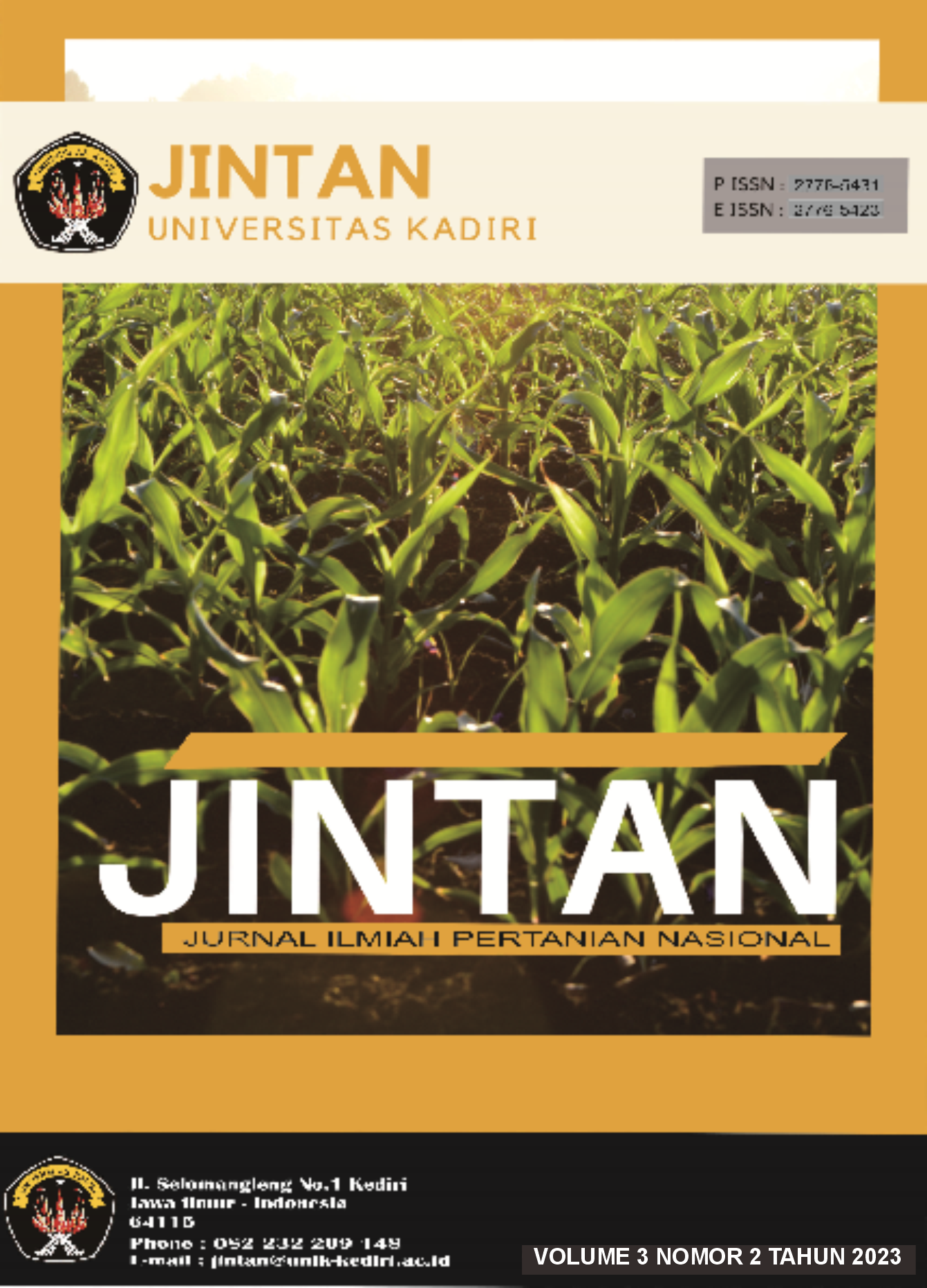Pemetaan Sebaran dan Populasi Beberapa Ternak Unggas di Kabupaten Sidoarjo Menggunakan Sistem Informasi Geografis (SIG)
DOI:
https://doi.org/10.30737/jintan.v3i2.4787Kata Kunci:
Poultry Mapping, Geographic Information System (GIS), Poultry Population DistributionAbstrak
This research aims to apply a Geographic Information System (GIS) in mapping the distribution of poultry populations in the Sidoarjo Regency. The main benefit of this research is accelerating the management of livestock distribution information in the area based on the mapping results. This information can be used as a reference in developing chicken farming businesses in the Sidoarjo Regency. This research used spatial data in administrative maps of Sidoarjo Regency in 2020, Indonesian Earth Maps sourced from National Geographic and poultry distribution data from Sidoarjo in 2021 and 2023 figures. Poultry population data fluctuates every year cause of several factors, including population factors, land availability factors, and demand and supply factors in the market. The districts with the highest distribution of poultry were Balongbendo Tulangan, Krian, Candi and Jabon. Districts with medium poultry distribution were Prambon, Tanggulangin, Porong, Sidoarjo, Buduran and Waru. The districts with the lowest distribution of poultry were Taman, Gedangan and Sedati. However, several sub-districts have experienced a significant decline.
Tujuan penelitian ini adalah menerapkan Sistem Informasi Geografis (SIG) dalam pemetaan sebaran populasi ternak unggas di Kabupaten Sidoarjo. Manfaat utama dari penelitian ini adalah mempercepat pengelolaan informasi sebaran ternak di wilayah Sidoarjo dengan menggunakan hasil pemetaan, informasi ini dapat digunakan sebagai acuan dalam pengembangan usaha ternak unggas di wilayah Sidoarjo. Penelitian ini menggunakan data spasial berupa peta administrasi Kabupaten Sidoarjo tahun 2020, Peta Rupa Bumi Indonesia bersumber National Geographic dan data sebaran ternak unggas yang bersumber dari Sidoarjo dalam angka tahun 2021 dan 2023. Setiap tahunnya, data populasi ternak unggas di Sidoarjo mengalami fluktuatif dikarenakan beberapa faktor yang mempengaruhinya yaitu faktor populasi jumlah penduduk, faktor ketersediaan lahan dan faktor permintaan dan penawaran harga unggas di pasaran. Kecamatan dengan sebaran ternak unggas tertinggi yaitu Balongbendo Tulangan, Krian, Candi dan Jabon. Kecamatan dengan sebaran ternak unggas sedang yaitu Prambon, Tanggulangin, Porong, Sidoarjo, Buduran dan Waru. Kecamatan dengan sebaran ternak unggas terendah yaitu Taman, Gedangan dan Sedati. Namun juga terdapat beberapa kecamatan yang mengalami penurunan cukup signifikan.
Referensi
Aditya, K. B., Setiawan, Y., & Puspitaningrum, D. (2018). Sistem Informasi Geografis Pemetaan Faktor-Faktor Yang Mempengaruhi Angka Kematian Ibu (Aki) Dan Angka Kematian Bayi (Akb) Dengan Metode K-Means Clustering (Studi Kasus: Provinsi Bengkulu). Jurnal Teknik Informatika, 10(1), 59–66. https://doi.org/10.15408/jti.v10i1.6817
Aryani, G. A. D., & Jember, I. M. (2019). Analisis Faktor-Faktor Yang Mempengaruhi Permintaan Daging Ayam Broiler Di Provinsi Bali. E-Jurnal EP Unud, 8(5), 1062–1091.
Awalin Khusnawati, N., & Kusuma, A. P. (2020). Sistem Informasi Geografis Pemetaan Potensi Wilayah Peternakan Menggunakan Weighted Overlay. Jurnal Mnemonic, 3(2), 21–29. https://doi.org/10.36040/mnemonic.v3i2.2788
Badan Pusat Statistik. (2021). Kabupaten Sidoarjo Dalam Angka 2021.
Badan Pusat Statistik. (2023). Kabupaten Sidoarjo Dalam Angka 2023.
Hadini, H. A., Nurtini, S., & Sulastri, E. (2012). Analisis Permintaan Dan Prediksi Konsumsi Serta Produksi Daging Broiler Di Kota Kendari Propinsi Sulawesi Tenggara. Buletin Peternakan, 35(3), 202. https://doi.org/10.21059/buletinpeternak.v35i3.1094
Kosasih, S. (2015). Sistem Informasi Geografis Pemetaan Tempat Kost Berbasis Web. CSRID (Computer Science Research and Its Development Journal), 6(3), 171. https://doi.org/10.22303/csrid.6.3.2014.171-181
Kunang, S. O., Kom, M., Kom, S., Universitas, D., & Darma, B. (2016). Sistem Informasi Geografis Pemetaan Populasi Hewan Ternak Di Sumatera Selatan Berbasis Web. 18(3).
Subkhie, H., Suryahadi, S., & Saleh, A. (2012). Feasibility Analysis of Chicken Ranch Business by Plasma Partnerships System in Ciampea Bogor. Manajemen IKM, 7(1), 54–63.
Sudrajat, & Isyanto, A. Y. (2018). Faktor-Faktor Yang Berpengaruh Terhadap Pendapatan Usaha Ternak Ayam Sentul Di Kabupaten Ciamis. Mimbar Agribisnis, 4(1), 70–83.
Widodo, W. (2009). Poultry feed security in the midst of a food crisis. Jurnal Salam, 12(1), 107–125.
Yacub, D. W., Zahro’, H. Z., & Vendyansyah, N. (2020). Rancang Bangun Sistem Informasi Geografis Untuk Potensi Ternak Pada Kab.Pasuruan Berbasis Web. JATI (Jurnal Mahasiswa Teknik Informatika), 4(2), 86–91. https://doi.org/10.36040/jati.v4i2.2727
Unduhan
Diterbitkan
Cara Mengutip
Terbitan
Bagian
Lisensi
Authors who publish in this journal agree to the following terms:
- Authors retain copyright and grant the journal right of first publication with the work simultaneously licensed under a Creative Commons Attribution License (https://creativecommons.org/licenses/by-nc-nd/4.0/) that allows others to share the work with an acknowledgment of the work's authorship and initial publication in this journal. Permitted third party reuse is defined by the Creative Commons Attribution-NonCommercial-NoDerivs (CC BY-NC-ND). This permission allows users to copy and distribute the Article, provided this is not done for commercial purposes and further does not permit distribution of the Article if it is changed or edited in any way, and provided the user gives appropriate credit (with a link to the formal publication through the relevant DOI), provides a link to the license, and that the licensor is not represented as endorsing the use made of the work.
- Authors are able to enter into separate, additional contractual arrangements for the non-exclusive distribution of the journal's published version of the work (e.g., post it to an institutional repository or publish it in a book), with an acknowledgment of its initial publication in this journal.
- Authors are permitted and encouraged to post their work online (e.g., in institutional repositories or on their website) prior to and during the submission process, as it can lead to productive exchanges, as well as earlier and greater citation of published work.
- For open-access publishing, authors have the right to share their articles in the same ways permitted to third parties under the relevant user license, as well as certain scholarly usage rights.




